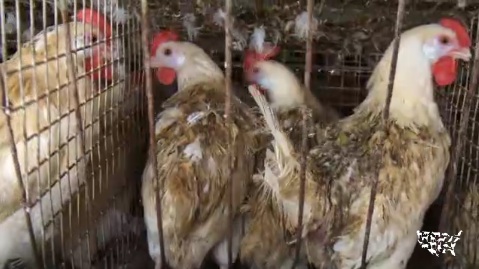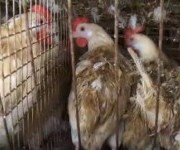 An undercover Humane Society video captured abuse on a factory chicken farm.The embattled livestock of our severely broken food system recently won a small victory. The USDA’s Food Safety and Inspection Service announced updated and more vigorous rules for federal inspectors to combat inhumane treatment of animals at USDA-inspected facilities. The rules go into effect Sept. 15 and will require personnel to:
An undercover Humane Society video captured abuse on a factory chicken farm.The embattled livestock of our severely broken food system recently won a small victory. The USDA’s Food Safety and Inspection Service announced updated and more vigorous rules for federal inspectors to combat inhumane treatment of animals at USDA-inspected facilities. The rules go into effect Sept. 15 and will require personnel to:
… ensure that treatment of livestock during handling and slaughter minimizes the animal’s amount of excitement, pain, injury or discomfort. Notably, this directive includes a definition for “egregious inhumane treatment”. Under this definition, an egregious situation is any act or condition that results in severe harm to animals, which includes the excessive beating or prodding of disabled livestock, stunning animals and allowing them to regain consciousness, or any treatment causing unnecessary pain and suffering.
Why the change? It appears that the recent set of undercover videos produced from within slaughterhouses and livestock facilities got the attention of more than just food reformers. Indeed, I think it’s fair to say that this rule change would not have happened if not for tireless efforts of groups like the Humane Society of the United States and Mercy for Animals.
The meat industry played an unwitting part, too — by pursuing so-called “ag-gag” laws that backfired. The debate over inhumane treatment of animals wouldn’t have achieved such prominence if not for the push by meat industry lobbyists for bills in several states that would have outlawed the videos that helped push the USDA to make regulatory improvements. All the bills failed, and the ensuing public relations fiasco only heightened awareness of the need for and benefits of transparency in our food production system.
This rule change alone won’t stop inhumane treatment of animals by livestock handlers; you need only read Tom Philpott’s description of how the meat industry turned abuse into a business model to realize how deeply ingrained these practices are. To accomplish real change we need much more significant reforms, like federally mandated reductions in slaughterhouse line speeds, elimination of the use of antibiotics (which allows for more dense packing of animals), or the establishment of minimum space requirements for animals.
Of course, USDA organic requirements already meet most the above standards and new research shows that adopting them would quickly improve animal health and reduce pathogens. It’s true that organic meat is significantly more expensive than supermarket meat, but much of the price premium comes from the costs of organic feed, which remains high because demand far outstrips current supply. Large-scale, conventional meat producers could adopt the above list without causing sticker shock for consumers (here’s how it could work for pork, for example).
Still, it’s worth applauding the USDA for empowering inspectors to be more aggressive in addressing inhumane treatment. Almost as important as the rule change itself is the message it sends: The USDA is reassuring its inspectors that the agency has their back on these kinds of penalties (not the case in other areas, sadly). The next step — which I fear we may never see — is for the USDA to own up to the fact that the meat industry’s addiction to unreasonably fast line speeds, sky-high production quotas, and closely packed masses of antibiotic-dosed livestock aren’t just bad for the animals — they’re bad for us.



